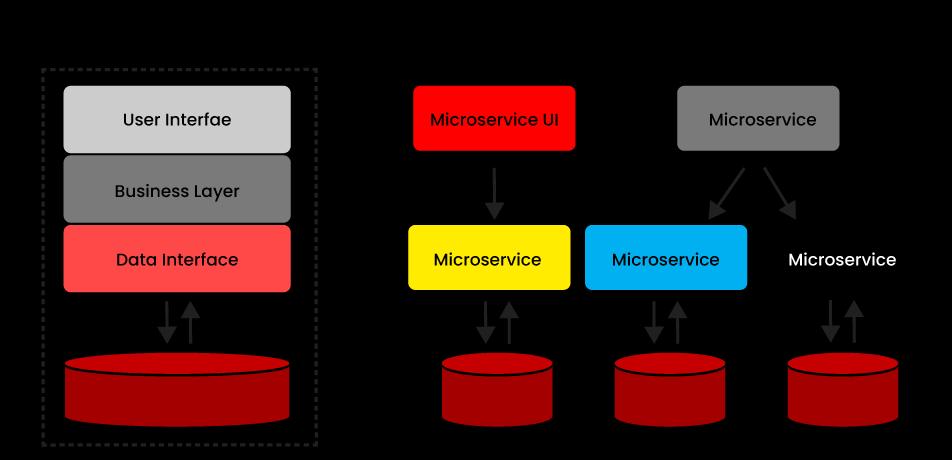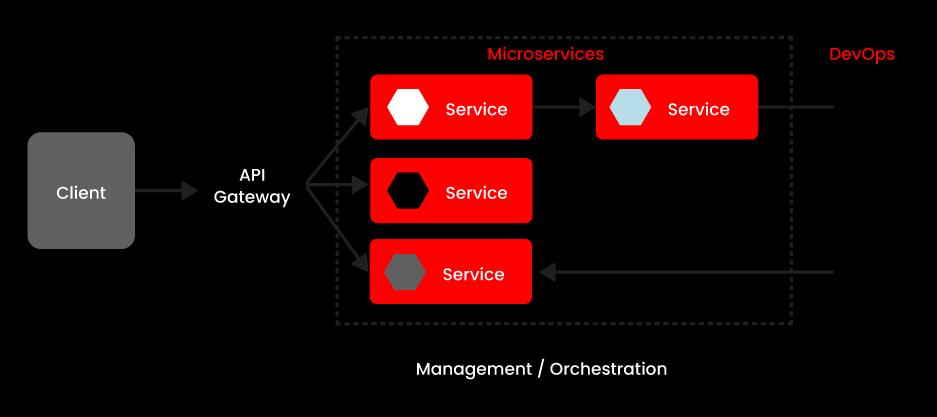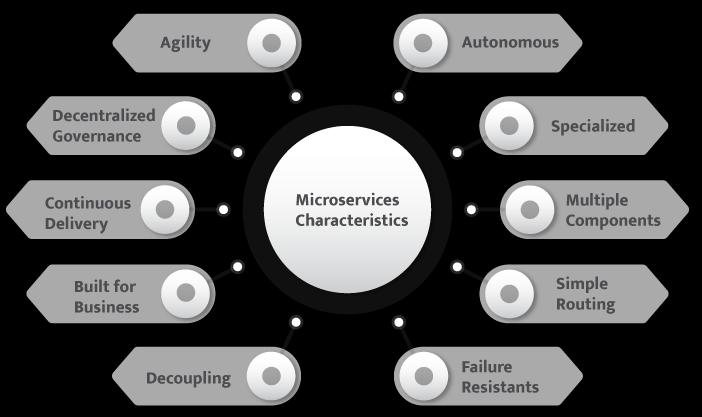- Home
- Blog
- Microservices
- What is Microservices?

- Cloud Native Microservices
- Microservices Interview Questions
- Microservices Tutorial
- Microservices With Spring Boot
- Security in Microservices
- Microservices vs SOA - What's the Difference?
- Top Microservices Tools
- Microservices vs API
- Top 10 Microservices Design Patterns and Principles
- Microservices Projects and Use Cases
Over the years, numerous technologies, best practices, and architectures have sprung up in the software development industry. Microservices is the architectural trend in the software development circles these days, which is being adopted by top organizations like Amazon, Netflix, Uber, eBay, and more in their products. The most important fact is that DevOps works very well with Microservices.
But what is Microservice? Why should you consider moving to a Microservice architecture?
This blog will clear all your doubts about getting started with Microservices.
| Table of Contents - Microservices Interview Questions |
|
|
To get a clear idea about Microservices, first, you need to understand the concept of Monolithic Architecture. In a Monolithic Architecture, all processes are coupled together and run as a single service. If any process of the application encounters difficulties, then you must scale the entire architecture. Adding or improving features of the monolithic application gets more complicated as code grows. The risk of failure is high in monolithic architecture as all processes are dependent and tightly coupled.

Microservices overcome the challenges that prevailed in Monolithic architecture. So, what a Microservice is?
What are Microservices?
Microservices (or Microservices architecture) is an architectural approach that structures an application as a collection of services that are highly maintainable and testable, independently deployable, loosely coupled, and organized around business capabilities. Small, self-contained teams on these services. In simple words, it's a method of development where an extensive application is divided into short modular services assisting a specific business goal.
| If you would like to Enrich your career with a Microservices certified professional, then visit Mindmajix - A Global online training platform: “Microservices Course”. This course will help you to achieve excellence in this domain |
What sets Microservices architecture apart from traditional, monolithic architectures is all processes are distributed and loosely coupled, so one team's changes won't break an entire app. It means individual services can function effectively without impacting others. In recent years, the trend for Microservices has seen an upsurge, as enterprises are looking to become more agile and move towards continuous testing and DevOps.
Next in this What is Microservices blog, let’s understand how many types of Microservices are available.
Types of Microservices
There are two types of Microservices:
- Stateless Microservices
- Stateful Microservices
1. Stateless Microservices
As the name suggests, stateless services do not maintain a session state between requests. For suppose, if any of the service instances gets removed, it won't affect the overall performance logic for the service. Distributed systems mostly prefer stateless Microservices.
2. Stateful Microservices
Stateful Microservices maintain session information in the code. When more than two Microservices interact with each other, they keep a service request state. In the real world, stateless Microservices are the best choice compared to stateful services.
Now, let's understand more about Microservices architecture.
Microservices Architecture

Microservices Architecture
The microservice architecture comprises a collection of small, autonomous services, where each service is self-contained and should implement a single business capability. If the application is complex, Microservices architecture lets you break it into component functionalities and create each of them into independent and self-contained services.
Each service is a separate codebase and communicates with each other through Application Programming Interfaces (APIs). There are some more components in the architecture, like management/orchestration and API gateway.
Management/orchestration - This component is responsible for identifying failures, placing services on nodes, and much more.
API gateway - It is an entry point for clients' gateway.
Now that you understand what a microservice architecture is. Next, let’s learn more about its characteristics.
Microservices Characteristics

Microservices Characteristics
- Decoupling - In Microservices architecture, services are decoupled to build, alter, and scale the applications quickly.
- Built for Business - Microservices usually are built around business capabilities and priorities.
- Continuous delivery - Allows frequent releases of software through systematic automation of software creation, testing, and approval.
- Decentralized Governance - Microservices architecture embraces the concept of decentralized data management.
- Agility - Any new feature can be developed or discarded easily.
- Autonomous - In Microservices architectures, each service you develop, deploy, scale and operate without affecting other services' functionality. They don't share any code or implantation process with other services and communication happens through APIs.
- Specialized - Each service is designed with a set of capabilities and used for solving a specified problem.
- Simple routing - Microservices are similar to UNIX systems: they receive a request, process, and generate a response accordingly.
- Multiple components - software built on Microservices architecture is broken down into multiple component services to deploy and redeploy independently without compromising on application integrity.
- Failure resistant - Microservices designed to cope with failure.
| Related Article: Microservices Architecture Tutorial |
How to Get Started with Microservices Architecture?
There is no particular way to get started with Microservices architecture. However, there are some common approaches in which many companies have adopted Microservices architecture and found success. Let's discuss them.
1. How to decompose
First, define the services corresponding to the business capabilities. Next, assign each service to a different team who are experts for those particular services. It often leads to stable API boundaries.
2. Building and Developing
After service boundaries are decided for those small services, they are developed by the teams using the technologies which are best suited for a particular purpose. After developing, through available CI servers (Jenkins, Go, etc.) CI/CD pipelines built to run automated test cases and to deploy services independently to different environments (QA, integration, Staging, etc.)
3. Designing services
Design the independent services carefully about what to be exposed to, what protocols are used to interact with the service, etc.
4. Decentralize
Organizations found success with Microservices followed a model where the teams building services take responsibility for everything related to that service. There are no separate maintenance teams. They are the ones who develop, deploy and maintain it.
There are some more architectural patterns that help in decentralizing things.
5. Deploy
There are two standard models used to deploy independent Microservices. They are multiple Microservices per operating system and one microservice per operating system.
6. Making standards
Creating the best standards and best practices while running the different services independently through multiple teams is always helpful in the long run.
7. Monitoring and logging
Services in Microservices architecture are distributed by nature; monitoring and logging of individual services can become a challenge. It's hard to go through and compare logs of each service instance and find out individual errors. Log aggregation and stats aggregation are used to solve such challenges.
- Log aggregation: It's one of the most preferred approaches to take advantage of the centralized logging service which aggregates logs from each service instance. Users can search through these logs from one centralized spot and configure alerts when specific messages appear.
- Stats aggregation: Similar to log aggregation, stats aggregation such as memory and CPU usage can also be leveraged and stored centrally. Tools like Graphite do an excellent job in pushing to a central repository and holding efficiently.
| Related Article: Microservices vs SOA |
Benefits of adopting Microservices Architecture
The benefits of Microservices seem strong enough to have convinced some top companies such as Netflix, eBay, and Amazon to adopt the methodology:
- Independently deployable: The most crucial benefit of Microservices is that the services are smaller and independently deployable.
- Simple to understand: Follow code easier since the function is isolated and less dependent.
- Highly scalable: Microservices allow each service to be independently scaled so that the demand for specific services increases, and you can deploy across various servers and infrastructures to meet your requirements.
- Ready for market faster: Microservices reduce the period of development cycles, and support for more agile deployment and updates.
- Reusable code: In Microservices, the software is divided into smaller modules enabling teams to utilize functions for multiple purposes. It, in turn, allows apps to bootstrap off themselves, as developers can create new capabilities without writing code from scratch.
- Resilient: Independent services, when failed, won't impact the performance of another one, unlike monolithic models.
- Faster defect isolation: When any service goes down, or test fails, you can isolate it quickly with Microservices.
- Reusable: Share small services like login systems or payment across the business.
- Technological freedom: Microservices won't follow a "one size fits all" approach. You have the freedom to choose the best tool, depending on your requirements.
| Related Article: Frequently Asked Microservices Interview Questions and Answers |
Challenges faced by Microservices Architecture
Despite the benefits of Microservices, it’s not always the best choice for every organization. The significant challenges faced with Microservices architecture are listed below:
- Testing limitation: Due to distributed deployment, testing can become complicated and tedious.
- Building: You should spend extra time identifying dependencies between the services. Finishing one build may trigger several other builds due to those dependencies.
- Versioning: Updating new versions will break backward compatibility.
- Monitoring: With Microservices, organizations may find it challenging to have a centralized view of the system to pinpoint sources of problems.
- Deployment: Sometimes, this is also a challenge, at least in the initial setup.
- Connectivity: Consider service discovery, whether integrated or centralized.
- Logging: You need centralized logs with distributed systems.
- Multiple technologies: Microservices architecture supports the use of various technologies and languages for building different services of the application. This concept finds some problems with real-life applications while using third-party assemblies and libraries.
Key Vertical Markets Demanding Microservices Architecture
Customers in a variety of verticals have a keen interest in the advantages of applications designed with the Microservices architecture are:
- Media and entertainment: Netflix moved to Microservices in 2009. Presently the service handles more than 2 billion edge requests every day via more than 500 Microservices.
- Retail: eBay and Amazon have demonstrated the value of Microservices to retail, including highly scalable services and more efficient ways of handling bug fixes and errors.
- Banking, Finance, and Insurance: The significant advantages of enabling Microservices to financial services include faster delivery of new functionality, enhanced security, and seamless integration.
- Healthcare: Healthcare Microservices Market size expected to reach $519 million by 2025 - Globenewswire.
- Government: In addition to the advantages of Microservices architecture, government organizations can also benefit from their ability to build a functionality that aligns with business goals, allowing software teams to develop or improve services based on constituents' needs.
| Related Article: Microservices Security |
The Future of Microservices
Enterprise adoption of Microservices is continuing to rise. Developers implementing Microservices as their default application architecture is expected to increase even more in the coming years.
Here are some of the predictions about Microservices for the coming years:
- Serverless/Function as a service: The future of microservice lies in serverless and function-as-a-service. The market for serverless architectures and on-demand computing resources will increase. Better tooling for rapidly developing and deploying Microservices will eliminate the requirement for a large upfront investment.
- Multiple Microservices: The future of Microservices will focus more on integration that ties the multiple Microservices together. Microsoft explored this idea in the past where the application can be built jointly by linking different services and APIs together.
- Cloud: One of the significant developments in the coming era will be the deeper integration of microservice offerings across Google Cloud, AWS, and Azure which brings added advantage of their specific features.
Conclusion
Microservices architecture is quickly becoming the preferred choice of building applications throughout industries. The benefits of Microservices are clearly worth it for growing numbers of modern software organizations.
With this, we've come to the end of this "What is Microservices" article. Hope the information shared was relevant for you. If you find this article helpful, please feel free to share it on other channels.
Got a question for us? Please comment below and will get back to you soon.
 On-Job Support Service
On-Job Support Service
Online Work Support for your on-job roles.

Our work-support plans provide precise options as per your project tasks. Whether you are a newbie or an experienced professional seeking assistance in completing project tasks, we are here with the following plans to meet your custom needs:
- Pay Per Hour
- Pay Per Week
- Monthly
| Name | Dates | |
|---|---|---|
| Microservices Training | Jan 13 to Jan 28 | View Details |
| Microservices Training | Jan 17 to Feb 01 | View Details |
| Microservices Training | Jan 20 to Feb 04 | View Details |
| Microservices Training | Jan 24 to Feb 08 | View Details |

Madhuri is a Senior Content Creator at MindMajix. She has written about a range of different topics on various technologies, which include, Splunk, Tensorflow, Selenium, and CEH. She spends most of her time researching on technology, and startups. Connect with her via LinkedIn and Twitter .















